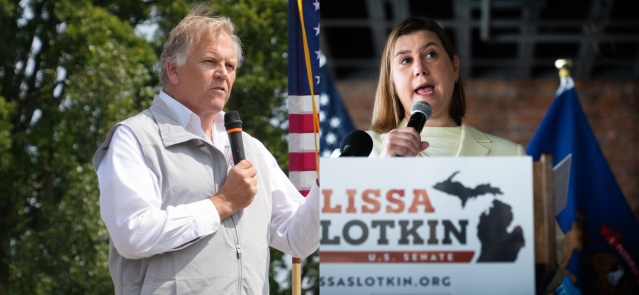Stay ahead of the curve as a political insider with deep policy analysis, daily briefings and policy-shaping tools.
Request a Demo
NCSL Staff Chair Sabrina Lewellen delivers opening remarks at the Legislative Summit in Louisville, Kentucky, on Aug. 5, 2024. (Credit: NCSL)
- NCSL director predicts Republican edge in state legislatures likely to continue in 2024
- Presidential wins don’t ensure state legislature gains for Democrats
- Local dynamics and Democrats: VP pick may influence state election outcomes
LOUISVILLE, Ky. — The Republican edge in state government nationwide is likely to continue, regardless of the outcome of the 2024 presidential election, an associate director of the National Conference of State Legislatures predicted Monday.
“The top of the ticket matters, but it’s not the whole ball game,” Ben Williams said during a discussion focused on potential factors and results of the election on the first day of NCSL’s annual summit in Louisville, Kentucky.
According to Williams, associate director of NCSL’s Elections & Redistricting program, Democrats’ success in presidential elections has not corresponded to what has happened in state legislatures historically.
In 2008, Barack Obama won by 7.3%, but Democrats picked up only 1.3% of legislative seats nationwide. In 2012, he won by 3.9%, and Democrats picked up only 1.4% of seats.
Then, in 2016, Hillary Clinton won the popular vote by 2.1%, while Democrats lost 4% of seats. And when President Joe Biden won in 2020 by 4.5%, his party lost 2.2% of seats nationwide.
“Just because you see these national trends does not mean that reflects at the state level,” Williams said.
Further complicating predictions is the unprecedented nature of this year’s presidential race: The sitting president dropped out late in the cycle, and the vice president now faces a former president who just survived an assassination attempt, Williams said.
In addition, Harris has yet to select a vice presidential running mate, and the home state of whomever she picks could see a half-point to 1-point uptick for Democrats.
That could have major implications if she chooses, for example, U.S. Sen. Mark Kelly, given Republicans have a one-seat majority in his home state of Arizona, Williams said.
Beyond national politics, “there are local dynamics that are always at play that can make a difference,” Williams added.
As it stands, Republicans control 57 chambers compared with Democrats’ 41 after nearly 50 years of blue dominance in state legislatures that was broken with the onset of the Tea Party in 2010.
Only Pennsylvania has chambers controlled by different parties.
Typically, only one party flips a chamber each election, but in some cases, more important than a flip is securing or breaking veto-proof majorities, as in Kansas.
Only nine states have a governor who is of a different party than the legislative majority, a trend common particularly in New England.
Williams said that number is at a historic low and so is likely to increase after November.
“Assume you will see more governors of the opposite party,” he said.
Williams also predicted that dramatic swings are unlikely, as 2010 and 2011 were the last years when more than 10 chambers flipped from one party to another.
“We just don’t see those dramatic swings anymore,” he said. “[In] 2018-2019 we saw nine and that was the recent high point. Expect fewer than that.”
And because Democrats would have to net nine flips in legislative chambers to take the national lead, it is unlikely they will overcome Republicans, Williams said.
Ballot measures
In addition to voting for candidates, most Americans will also vote on statewide issues, according to Helen Brewer, a policy specialist with NCSL’s Elections & Redistricting program.
As of Monday morning, 141 ballot measures were certified at the state level.
The most common focus is taxes, appearing as 40 issues in 18 states, including Georgia’s proposed expansion of the homestead tax exemption.
Elections, particularly the use of ranked choice voting, is also popular, encompassing 30 measures in 22 states. Brewer also included in that category Ohio’s citizen-initiated constitutional amendment for an independent redistricting commission.
Civil and criminal justice is another common theme, accounting for 17 measures in 10 states, such as Arizona’s proposal for mandatory life sentences for child sex trafficking.
Five states will consider whether to establish the constitutional right to abortion.
“Every ballot measure related to abortion that has appeared on the ballot since the Dobbs case in 2022 has turned out in favor of pro-abortion advocates,” Brewer said. “We will see if that holds true this year.”
Of particular note, she added, is Florida, which requires a 60% supermajority for constitutional amendments.
“It will be interesting to see whether that post-Dobbs trend holds true, even in a state with such a high passage threshold,” Brewer said.
Krista Kano is a staff writer for Gongwer Ohio/State Affairs. Reach her at [email protected] or on X @krista_kano.
COMMENTARY: Happy 100th birthday, Mr. Jimmy!
“I missed you at Sunday school today,” Mr. Jimmy said to me as he entered the back door of what once was a boarding house where his parents lived when they were first married. He always stopped to speak with me in the kitchen before mingling with the nearly 45 people gathered in anticipation of …
Want to see the election process up close? Become a poll worker
Looking for a temporary job that gives you a glimpse of how the American election process works? If so, Georgia election officials are looking for you. Many local election offices have begun training thousands of temporary poll workers and other essential staff for the Nov. 5 general election, according to W. Travis Doss III, president …
Rogers, Slotkin lean into China, national security in US Senate battle
LANSING, Mich. — Michigan voters are faced with a choice for U.S. Senate in November between two candidates with strong national security credentials but with sharply different views on how to effectively address threats to the U.S. Both Southeast Michigan candidates, Republican Mike Rogers of White Lake and Democratic U.S. Rep. Elissa Slotkin of Holly, have been …
Tammy Baldwin faces tough reelection: Can Trump supporters push her past the finish line?
MADISON, Wis. — Tammy Baldwin may need some Donald Trump supporters to secure her reelection. The two-term U.S. senator plays up the “buy American” language she pushed for federal infrastructure projects and touts policies favored by Wisconsin’s dairy industry such as seeking to ban labeling plant-based products “milk.” Her GOP rival Eric Hovde, meanwhile, wants …




